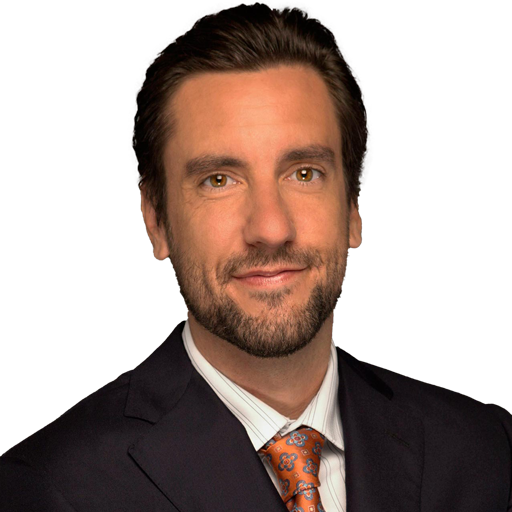Washington Post tried to oust Bill Clinton but skips over Joe Biden's corruption. What changed?
We've seen major allegations about President Biden and his family's corrupt behavior break this month. The Washington Post just looks past it
Clay Travis: The left-wing media is desperate to label things as racist, White supremacist
OutKick founder Clay Travis reacts to the MSNBC op-ed tying working out to the far-right
Editor's note: The following column was originally published on OutKick.
In my freshman year of college at George Washington University, I woke up to read the front page of the Washington Post pretty much every day. But the front page on that January day in 1998 was truly a blockbuster – news broke that morning that President Bill Clinton was accused of having an affair with former intern Monica Lewinsky.
It was one of the last times in my life, maybe the last time, that I would see news legitimately break on the front page of a newspaper. (The rise of the Internet was upon us in 1998, but at this point in time most news still broke on television or in newspapers for the vast majority of us. The internet still had credibility issues. That’s why the Drudge Report hitting the Lewinsky scandal a few days before didn’t have nearly the impact it would now.)
From that point forward, over the next several years, the Washington Post relentlessly tracked and reported on the Clinton-Lewinsky scandal. I was just a college kid, but it certainly felt to me, who subscribed to the Post and read it every day, that the paper wasn’t pulling its punches when it came to the Clinton impeachment drama. The Washington Post broke its fair share of news stories on the incident and it was regularly on the front page of the newspaper, literally for years during my college tenure.
I’ve been thinking about this quite a bit lately because, in the past few days, we’ve had three major blockbuster revelations drop recently about President Joe Biden.
First, two IRS whistleblowers testified under oath that Hunter Biden received preferential treatment, protection from serious felony charges, and a sweetheart deal from his dad’s justice department.
Second, an FBI agent testified under oath that the FBI had known the Hunter Biden laptop was 100% real when the New York Post broke the story about Joe and Hunter Biden’s business dealings in October of 2020, yet the FBI had refused to confirm its veracity to the major social media companies, leading to a censoring of an important news story in the weeks before the election.
Third, an FBI informant reported that Joe and Hunter Biden had been paid $5 million each to aid Burisma, a Ukrainian oil company, while Joe Biden was vice president, including getting a Ukrainian prosecutor fired, among other work.
Set politics aside and look at The Washington Post’s reporting
Now whatever your politics are – full disclosure, I volunteered on the Bill Clinton presidential campaign in 1996 as a high school kid and voted for Donald Trump in 2020, so I’ve covered the full political gamut in the past 25 years – which do you think is a more significant political accusation deserving of rigorous political investigation? That a president had a sexual dalliance with an intern and later lied about it or that a president may have made millions of dollars from foreign businesses to advocate for their interests while he was in office, that a president protected his son from the consequences of his felonious behavior through a sweetheart deal with his own justice department, and that the FBI protected Joe Biden and Hunter Biden from the perils on a laptop by allowing 51 intelligence agents to lie about that laptop, ensuring that majorities of Democrat voters, even to this day, still believe the Hunter Biden laptop was Russian disinformation and helping to ensure that Biden was elected in 2020?
I mean, this is no contest, right?
The allegations against Joe Biden this past week alone are far more consequential than the allegations against Bill Clinton ever were during his presidency. Yet the Washington Post of 1998 went after Clinton with the full might of its reporting arsenal and subscribers to the Washington Post today may well not have read a single article about Biden’s troubles this month.
How does this happen? How was the Post, just 25 years ago willing to, potentially, bring down Bill Clinton’s presidency over an Oval Office oral sex encounter and yet can’t be bothered to cover the far more serious allegations against President Joe Biden today?
PHOTOS SHOW HUNTER BIDEN IN DAD'S CORVETTE AT DELAWARE HOME ON SAME DAY AS 'SHAKEDOWN' MESSAGE
I’ve got a theory, one that explains much of the modern issues with American politics writ large. How we got to our current state in American media is something I spend a great deal of time thinking about because I was a subscriber to the Washington Post as an 18-year-old and I’m still a subscriber today.
How was the Post, just 25 years ago willing to, potentially, bring down Bill Clinton’s presidency over an Oval Office oral sex encounter and yet can’t be bothered to cover the far more serious allegations against President Joe Biden today?
(In college, I would read four newspapers — The Washington Post, the New York Times, the Wall Street Journal and the USA Today — and read each of them cover to cover. Even today I feel like the last man on Earth who still reads print newspapers.
I get the New York Times and the Wall Street Journal delivered to my house and I had a panic attack flying from Los Angeles to New York recently when I realized LAX AIRPORT NO LONGER SELLS PRINT NEWSPAPERS!! During one flight to London, I entered the airplane with, and this is not a joke, 12 newspapers to read as we crossed the Atlantic. My wife and kids are embarrassed to sit with me because of the amount of space all these newspapers take up when we fly.
My point here — I love newspapers. Even the ones that publish articles that I wholeheartedly disagree with. When people ask why I love print newspapers, it’s because of the thrill of the serendipitous. Today’s algorithms feed you stories they 100% know you’ll like, but the stories I most enjoy reading in the print newspaper are stories I would have never known existed if I only used the newspaper apps.
In the last couple of days, I’ve read about the discovery of a new Mayan village, revenue produced by recent American movies in China, and the selling of a butterfly house on the coast of California. And these are just the stories I remember off the top of my head. They weren’t on the front pages of the newspaper apps, I only saw them because I read the print paper.)
Given my obsession with media, it’s probably not a surprise that I would one day grow up and found my own media company -- OutKick, the one that Fox now owns.
My point here is that I’m a critic, but I’m also a critic who loves newspapers and thinks they play an incredibly important role in holding the rich and powerful accountable in our country.
How then did the Washington Post, and other outlets, get here?
What happened in the past 25 years? How did we go from the Washington Post covering one Democrat president, Bill Clinton, extensively and giving another Democrat president, Joe Biden, a complete pass on far more serious accusations? I think the answer is business imperatives, this 25-year period represents the switch from a business model primarily fueled by advertisers to one primarily fueled by subscribers.

Washington Post newspaper in a D.C. neighborhood. (Fox News Photo/Joshua Comins)
In 1998 — and in the 1970s when the Washington Post brought down Richard Nixon with its Watergate stories — the goal of a newspaper was to get as many readers as possible. (That’s why newspapers were giving away their product to college kids like me in the late 1990s and the early 2000s.)
Why did you want to get as many readers as possible? Because then your ad rates went higher. (The newspaper, as a business model, is really just a way to deliver advertisements to your doorstep.) When I got to college, the Washington Post cost a quarter on newsstands. Even then, I thought it was insanely cheap. The paper didn’t make money by selling its content, it made money by selling ads.
But the content was the hook because the best way to get the most eyeballs on your product was to write content that everyone cared about.
Everyone read the Post in that 1990s era in Washington, D.C. -- Democrats, Republicans, independents, suffering Washington Redskins fans -- all of us. Plus, the legacy of Watergate was something important, the Post genuinely thought its goal was to hold the powerful accountable. Everyone wanted to be the next Woodward or Bernstein. So, the Post covered Clinton’s oral sex controversy like it was Watergate.
Most in media don’t understand basic business, but the print newspaper could charge a ton for ads because they were in finite supply. There are only so many ads a print newspaper can have. (The most profitable part of the paper, of course, was the classified ads, which were a complete business gold mine until Craig’s List destroyed that revenue stream forever.) Most papers had monopolies in their local markets and those monopolies became more profitable the more people who read the content.
BIDEN'S CLAIM TO HAVE NO KNOWLEDGE OF HUNTER'S BUSINESS DEALINGS IS BECOMING HARDER TO MAINTAIN
So, while there might have been a news bias, the bias wasn’t overt, the Post was a left of center paper, but it was still willing to eviscerate Bill Clinton over oral sex with an intern in the Oval Office. (Full disclosure, I never really cared much about Bill Clinton’s shenanigans and thought he was a pretty good president. I would rather the president screw a few people than the entire country, but maybe that’s just me.)
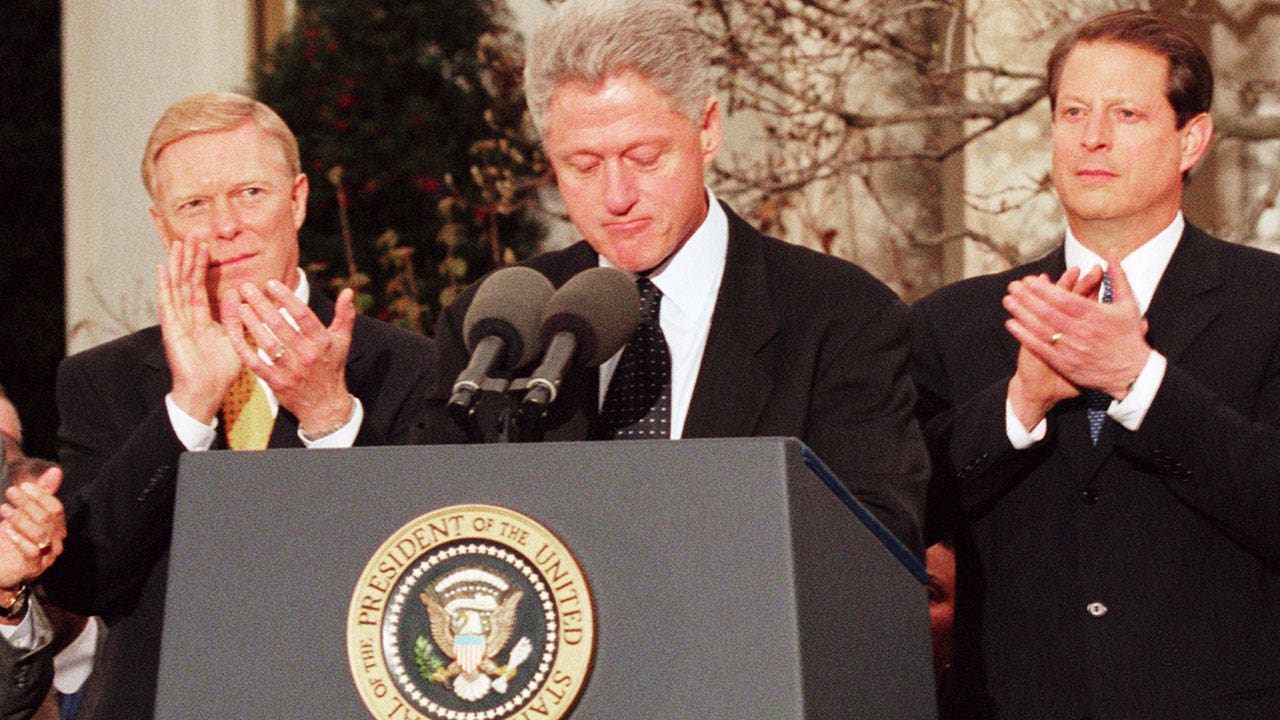
FILE – President Bill Clinton reacts to being impeached by the House of Representatives outside of the oval office in the White House Rose Garden, Washington, DC, December 19, 1998. (L-R), Chief of Staff John Podesta, House Minority Leader Richard Gephardt, Clinton, Vice President Al Gore, First Lady Hillary Rodham Clinton. (Photo by David Hume Kennerly/Getty Images) (David Hume Kennerly/Getty Images)
But the rise of the Internet changed things. Because a limited number of pages to sell ads on in a newspaper — or a magazine — became an infinite supply on the Internet. And just about every newspaper business model collapsed as everyone raced to put content online.
The business model changed for traditional (legacy) media
The end result for the Post?
A decline in quality and profit that culminated in Jeff Bezos, the founder of Amazon, buying the paper for $250 million.
WASHINGTON POST INSIDERS WORRY PAPER 'LOST AT SEA' AS HIGH-PROFILE EXITS, FINANCIAL HEADACHES MOUNT
Eventually, the Washington Post and the New York Times settled on a new business imperative — online subscriptions. This was the savior of the business that otherwise was going to lead to bankruptcy. Paywalls went up online limiting how much of their product readers could consume for free and everyone had to pay for content.
Let me pause here for a second and ask a question, do you know what one of the most profitable subscription media businesses is online so far? (For purposes of this exercise we’re excluding pornography, which has been an incredible subscription business model online.)
The answer is sports message boards, particularly college sports message boards. And do you know what drives most of those subscriptions? Recruiting.
Diehard fans of college teams will subscribe like crazy for the latest information on college and basketball recruits. This information is otherwise not widely covered because it’s a niche. Most people, you lucky ones, don’t care what 16- and 17-year-old boys think of colleges. I’ve been a subscriber to college message boards for over 20 years. Even to this day, at 44 years old, when a top recruit is announcing his decision, I click almost instantly to see if he’s picking my favorite college team, the University of Tennessee. Right now, I can rattle off the top 15 teams in the constantly updated On 3 composite college football recruiting class rankings. I realize some of you think this is a strange obsession, and I don’t disagree with you, it is kind of weird, but it’s an incredible business.
There are millions of recruiting diehards like me.
Now, to be clear, we aren’t the average fan, most fans go to games and casually follow recruiting, we’re the guys who have text chains with our buddies that say something like, "I’ve looked at his film and I don’t see how (insert recruit here) isn’t a five star." Yes, we legit watch high school highlight tapes and debate how highly ranked players are or should be. Again, I’m not claiming this is normal for grown men to do, but there are millions of us that obsess over this stuff.
My friend Shannon Terry, who also lives in Nashville, has sold Rivals to Yahoo, 24/7 to CBS, and I’m sure he’s got a bevy of big media companies already bidding to buy On 3, his latest offering in the college recruiting space.
I’ve followed these businesses as a fan and subscriber for 20 years now.
And do you know what’s never happened? None of these team sites, not the Ohio State, Alabama, Tennessee, Texas, Florida State, Syracuse, USC, none of them, have ever broken a story, to my knowledge, that has resulted in the team they cover getting put on NCAA probation. Why is that? I mean, surely some of these guys have been aware of recruits getting paid, players driving cars they couldn’t afford, coaches breaking rules, you name it. The message board sites have better connections inside the programs they cover than almost anyone.
The Washington Post and the New York Times have become, essentially, fan message board sites.
Yet it’s never these sites that break negative news. (I don’t mean coaches getting fired, I mean news that causes probation, news that would have otherwise never gone public.)
Why don’t these sites ever break this kind of news?
It’s because the business model would collapse if that happened.
Consumers buy things they like and agree with
Sports fans pay for subscriptions to things they like. They don’t want the people they pay for subscriptions to tell them bad things about their favorite teams. They don’t want them to destroy the thing they love. Doing that would destroy the entire business.
GOP RIPS HUNTER'S ‘SWEETHEART’ PLEA DEAL ON TAX AND GUN CRIMES, ZERO IN ON JOE BIDEN
And that’s when it hit me as I was writing my latest book, "American Playbook," which will be out on August 8, why weren’t the Washington Post and the New York Times covering news in a remotely fair way in the Donald Trump and Joe Biden era? Because they are fan subscription businesses now.
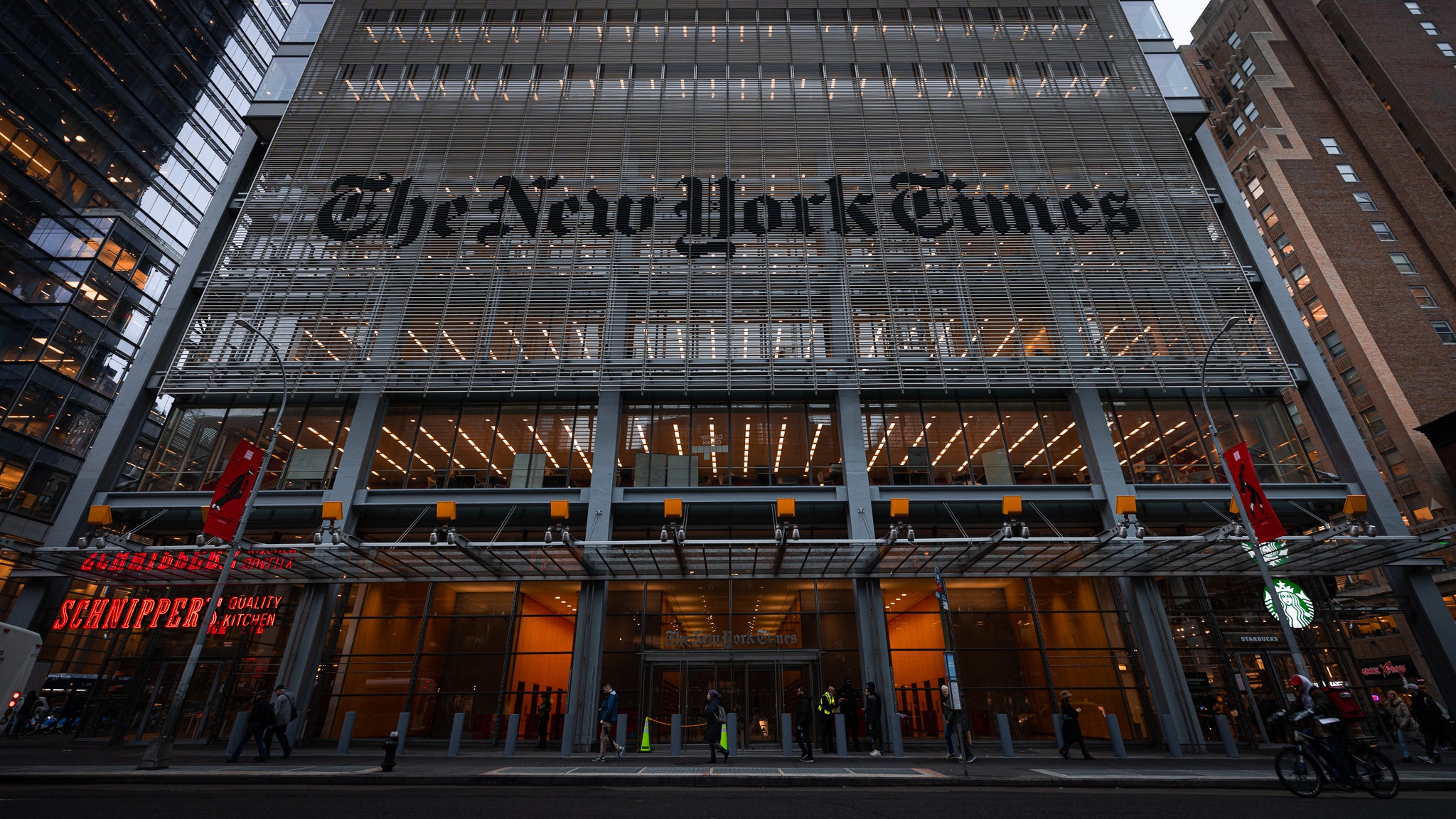
FILE – The New York Times building in New York City. (Fox News Photo/Joshua Comins)
The Washington Post can’t tell the truth to their audience about Joe Biden’s corruption because if it does subscriptions will tank and people will stop paying to read. Already news broke recently that the Post has lost 500,000 subscribers since Donald Trump left office. People signed up to pay the Post to tell them that Trump was Hitler. That’s why they emblazoned "Democracy Dies In Darkness" at the top of the newspaper. But without the great Satan, Trump, the Post doesn’t have a fan base.
That’s why the paper is on track to lose $100 million this year. That’s a drop in the bucket for Bezos, but it’s also chilling.
Imagine what those subscriptions would look like if the Post started telling the truth about the Bidens to its subscribers. The Post would be under a million subscribers by next year, the entire business would collapse overnight.

FILE – Amazon founder Jeff Bezos greets fans before the start of an NFL football game between the Kansas City Chiefs and the Los Angeles Chargers Thursday, Sept. 15, 2022, in Kansas City, Mo. (AP Photo/Ed Zurga)
The Washington Post and the New York Times have become, essentially, fan message board sites. They rep the Democrat team. Just like with the individual team sites who don’t break bad news about their team, anything that makes the Democrat team look bad destroys their business.
OBAMA-ERA EMAILS REVEAL HUNTER'S EXTENSIVE TIES TO NEARLY A DOZEN SENIOR-LEVEL BIDEN ADMIN AIDES
People don’t want to be told the truth when it comes to their news subscriptions, they want to be told that their side is good and the other side is evil.
In 1998, the business imperatives of the Washington Post demanded that it cover Bill Clinton’s sex scandals, at least mostly, impartially. By 2023 the Post’s business imperatives demand that they ignore the Joe Biden scandals because if they cover them too aggressively their remaining subscribers quit. I guarantee you that’s exactly what the Post analytics show. Every time they write a moderately negative article about Democrats, they lose more subscribers. Every time they write an article that rips the Republicans, Donald Trump, and Ron DeSanctis to the high heavens they add a few subscriptions.
The problem is that’s not journalism, it’s paid propaganda.
Journalism has Died at Places like The Washington Post
It’s also fascinating because of the twist with sports message boards. When I pay to read more about Tennessee football recruits, I’m not also paying for my site to write awful things about rival programs. That is, the writers on these individual sports sites aren’t undertaking "investigative" journalism about other schools. They pretty much cover their own teams, they don’t try to destroy other teams.
The Washington Post and the New York Times aren’t just Democrat fan sites, they’re also engaged in daily attacks on the other political party. That is, the subscribers to these newspapers aren’t just paying to hear that their team is awesome, they’re also paying to have the other team attacked.
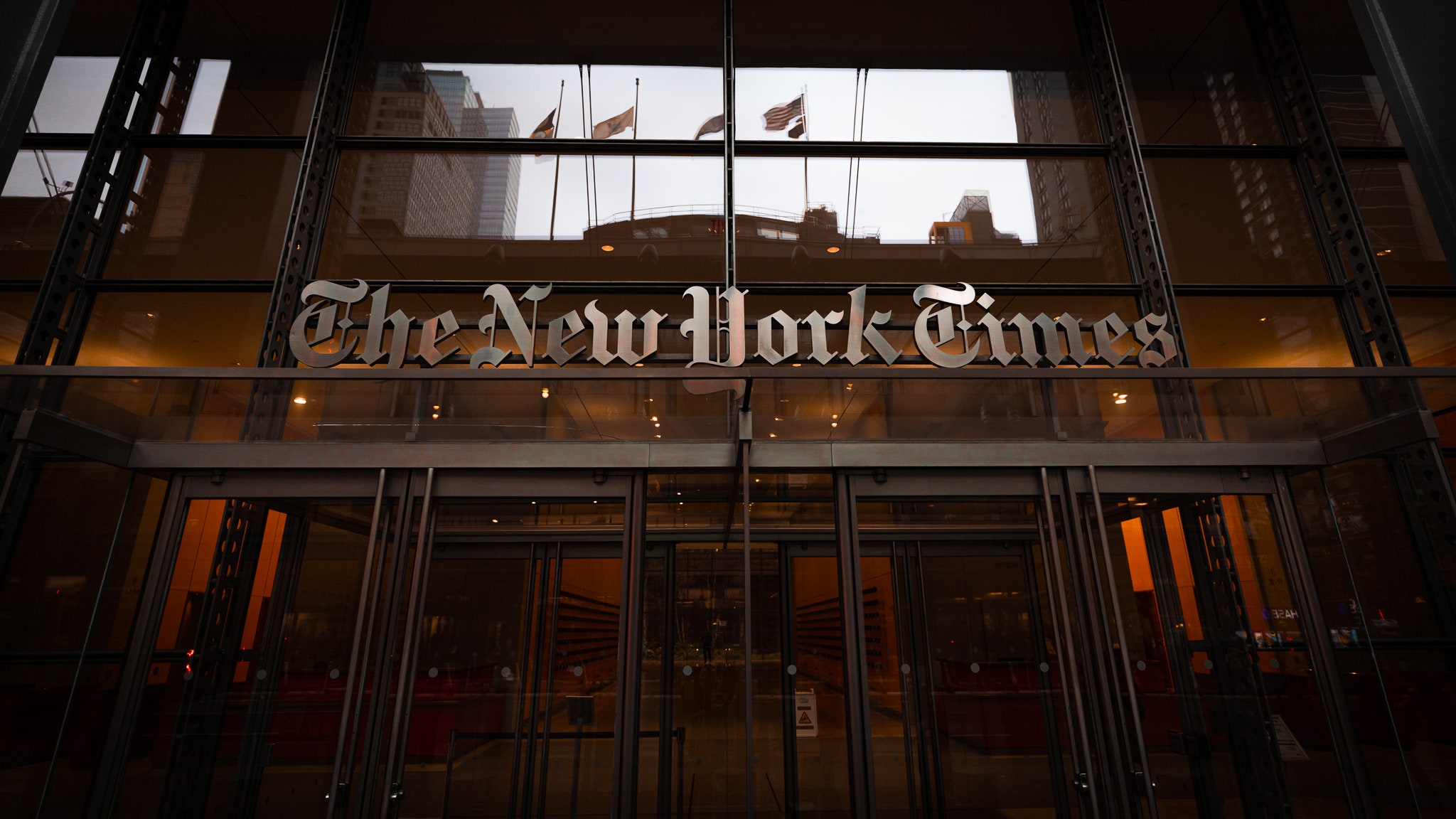
The outside of the New York Times Building pictured in midtown Manhattan. (Fox News Photo/Joshua Comins)
So if you’re reading this right now and you’ve wondered how we got here, you’re probably slowly nodding your head. And here’s the scary thing, while it may be tempting to blame the media, here’s the scary truth — no site in America is paid to cover the news completely honestly. (The Wall Street Journal probably comes the closest on a subscription basis, but I’d argue that’s because it’s overriding focus is business, not politics.)
Think about that, we’ve created a modern media subscription news business where truth and honesty don’t pay because no one will buy it. Most consumers don’t want truth and honesty, they want to pay legacy media to tell them that they’re right and the people they disagree with are wrong. (This gets even funnier when the Post and the New York Times employ "fact-checkers" who miraculously always tell their audiences that their side is always telling the truth.)
CLICK HERE TO GET THE OPINION NEWSLETTER
(Inevitably people who don’t read this article will scream, what about Fox News?! There is no conservative subscription news platform with a pinprick of the millions of Times and Post subscribers. People can rip Fox News all they want, but it’s in the cable news business like MSNBC and CNN. There are conservative news subscription sites like the Daily Wire, but they focus mostly on opinion, not "news" coverage.)
OK, so many of you probably agree with my overall thesis here and you are rightly thinking, how do we fix this?
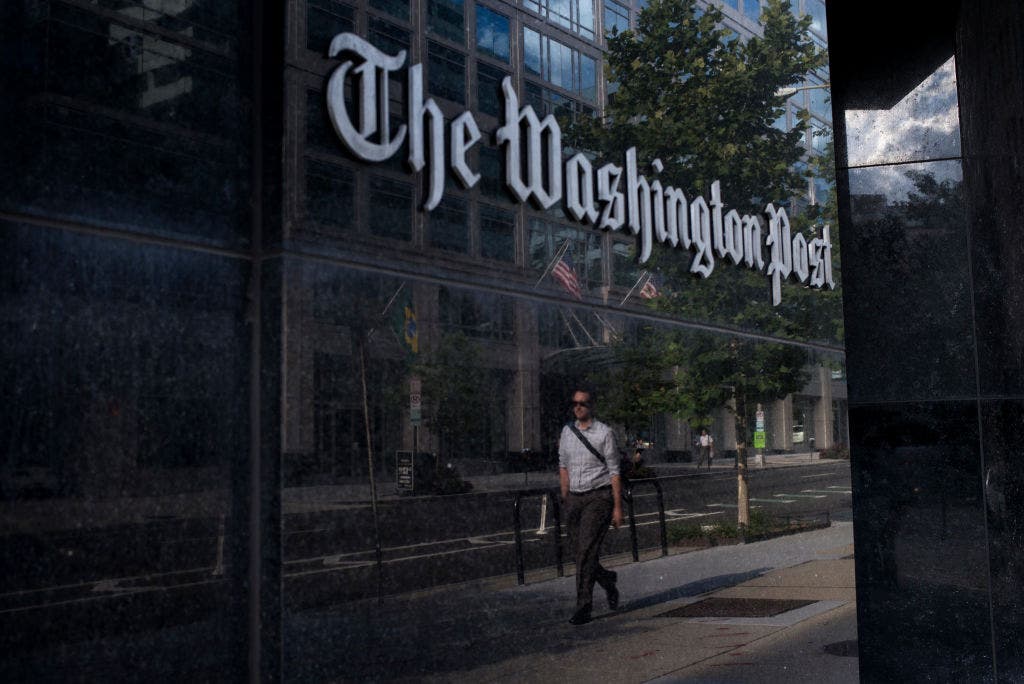
A man walks past The Washington Post on August 5, 2013 in Washington, DC after it was announced that Amazon.com founder and CEO Jeff Bezos had agreed to purchase the Post for $250 million.
The answer is, I don’t know. A part of me hopes that someone like Jeff Bezos, who has more money than he can ever spend, has to see what’s happened to the Post and would recognize the importance of returning, even if it costs him some money, a media outlet to honest, middle of the road analysis. Heck, the reason I founded OutKick was because no one else would do the sports coverage we do here. Staggeringly, even with the growth of this site to a top 10 sports property, we still don’t have any true competition when it comes to publishing non-woke centrist and fun sports coverage.
Media Model Needs an Overhaul
But I think one thing everyone in media has to do is recognize what’s taking place here. There are virtually no impartial media outlets in this country today. The Washington Post and The New York Times still receive an awful lot of legacy legitimacy because of their work over the prior decades, but they’ve now become partisan fan sites, referees taking the field who have been bought and paid for by one side already. Their corruption is all the more toxic because they claim to be impartial. I disagree with much of what MSNBC presents on a daily basis, but at least it doesn’t hide its political direction.
The moment is ripe, I truly believe, for a complete disruption of all legacy media. Because I believe the vast majority of Americans are desperate for more media they can trust, for media that calls honest balls and strikes.
But right now, you get what you pay for – lies, deceit and corrupt officiating crews.
The Washington Post cared more about Bill Clinton’s oral sex in the Oval Office in 1998 than it does about Joe Biden’s clear corruption in 2023.
CLICK HERE TO GET THE FOX NEWS APP
And it’s not an accident.
It’s what it is paid to do.
Author's note: My new book, "American Playbook," will be released on Aug. 8. You can buy it here.
